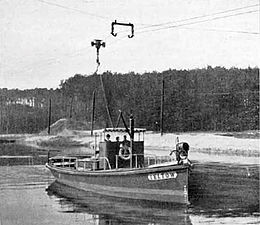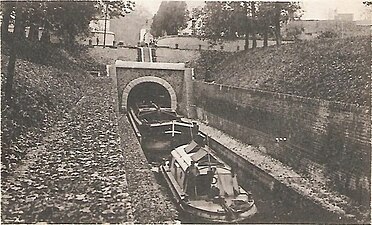Trolley boat

A trolley boat (a descriptive neologism not used contemporaneously) is an electrically driven boat on canals and particularly in canal tunnels. It takes its energy like a tram or trolleybus from one or two overhead wires respectively.[1]
History

Frank W. Hawley converted a conventional steam-driven canal boat into a trolley boat and demonstrated its benefits and limitations 1893 on the Erie Canal. It had two electric motors with 19 kW (25 hp) each, which drove the propellers.[1]
On a 21⁄2 miles (4 km) long section of the Brussels–Charleroi Canal operated from 1899 a propeller driven trolley boat as a tug. Another installation was built in 1933 on a section of the Marne–Rhine Canal and is still in use. A 33⁄4 miles (6 km) long overhead cable was installed at the 2 miles (3,3 km) long canal tunnel of the Canal de Bourgogne in the French Canton de Pouilly-en-Auxois.[1]
In 2012 Diversified Marine in
Additional photographs
-
Trolley boat on the Brussels–Charleroi Canal
-
Teltow, a trolley boat on the Teltow Canal
-
Trolley boat at the canal tunnel of Pouilly-en-Auxois
References
- ^ a b c "Trolley canal boats". Low Tech Magazine. Retrieved 15 December 2015.
- ^ Buena Vista (Oregon) ferry retired, new boat comin.



